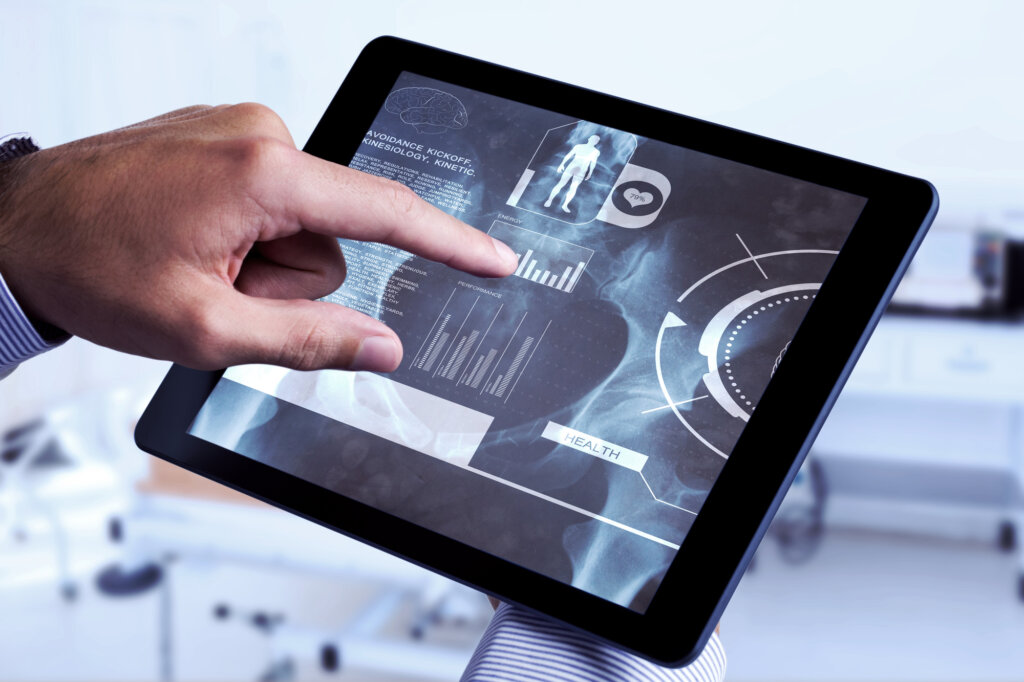 Insight Florence Nguuni on prioritising patient-centric design: the role of data and data visualisation in transforming healthcare
Insight Florence Nguuni on prioritising patient-centric design: the role of data and data visualisation in transforming healthcare
The complex relationship between health and data has evolved drastically over the past century, especially in how we approach patient-centric design. Florence Nguuni guides us through the shift towards data-driven decision-making in healthcare and how we can shape a future that puts the patient first.

In the dimly lit office of a Kenyan hospital’s administrative centre, Mary, a seasoned hospital administrator, finds herself engulfed in a sea of perplexing numbers and raw data. As a steward of healthcare in Kenya, entrusted with the intricate task of guiding the institution towards a brighter future, the day brings a particularly daunting challenge: a lack of context and meaningful visualisations.
Rows upon rows of patient statistics are sprawled across Mary’s desk – names, admission dates, treatments administered, and a labyrinth of medical codes. The numbers dance before her eyes, as elusive as constellations in the night sky, their significance shrouded in ambiguity. The sterile walls of the office seem to close in; the unforgiving fluorescent lights cast a harsh glare on the figures, heightening Mary’s sense of unease.
These numbers are more than mere digits; they represent the lives of countless cancer patients seeking care within the hospital’s walls. While Kenya’s healthcare landscape faces its unique challenges, the statistic that haunts Mary most is the global one: every year, preventable medical errors claim the lives of over 400,000 patients in the US alone (1), making it the third leading cause of death in the country after heart disease and cancer.
Over the past decade, Mary has witnessed a remarkable shift in healthcare in Kenya. From the way doctors diagnose diseases to how hospitals manage patient records, technology has infiltrated every facet of the healthcare system. But amidst this technological revolution, one aspect stands out: the ways in which data and data visualisation are reshaping the patient experience. With the statistics looming large and the need for change ever more pressing, Mary knows that embracing data-driven solutions is not just an option but a lifeline for Kenyan healthcare.
In Kenya, the lack of contextual understanding and meaningful data visualisations represents a significant challenge within the vast pool of patient statistics. This absence of clarity hinders informed decision-making and quality patient care, while the global issue of preventable medical errors underscores the urgency for data-driven solutions to improve healthcare outcomes and patient experiences. As a result, it is imperative for healthcare professionals, administrators, policymakers, and stakeholders to take heed of the transformation towards patient-centric healthcare design – driven by data and data visualisation.
The challenge affects the full spectrum of healthcare professionals in their quest to improve the levels of care provided to patients:
- Healthcare professionals often grapple with the challenge of delivering the best patient care, and the lack of insightful data can hinder clinical decision-making and the resulting patient outcomes.
- Administrators face the daunting task of managing healthcare institutions efficiently, and a lack of effective data utilisation can lead to resource wastage and inefficiencies.
- Policymakers aim to create policies that enhance healthcare accessibility and quality, and an understanding of the significance of data in this process is paramount.
- Stakeholders, from investors to patients themselves, seek improved healthcare delivery and demand more transparent insights. By embracing patient-centric design and the power of data visualisation, these pain points can be addressed, paving the way for better healthcare outcomes, improved resource allocation, more effective policies, and enhanced patient experiences.
Understanding patient-centric design: a quick chronology

“Providing care that is respectful of, and responsive to, individual patient preferences, needs, and values, and ensuring that patient values guide all clinical decisions.” This is how the Institute of Medicine (IOM) defines patient-centred care. Imagine a healthcare approach where patients are not passive recipients but active partners in their care journey. Patient-centric design, at its core, revolves around this philosophy, placing patients and their needs at the forefront of all decisions and practices. Guided by principles such as individualised care, empowerment, open communication, respect for patient preferences, and the creation of welcoming healthcare environments, this transformative approach has the potential to significantly improve patient outcomes, enhance the overall healthcare experience, and drive greater patient satisfaction.
In more detail, patient-centric design prioritises:
- Individualised care – Recognising that each patient is unique, it seeks to deliver highly personalised care and treatment plans.
- Empowerment – It empowers patients to take control of their health and wellbeing, offering a partnership rather than a one-sided approach.
- Communication – Open and transparent communication between healthcare providers (HCPs) and patients is a fundamental aspect, fostering trust and cooperation.
- Respect for patient preferences – Following the IOM’s definition, it ensures that care is respectful of, and responsive to, individual patient preferences, needs, and values. Patient values guide all clinical decisions.
- Comfort and environment – It encompasses designing healthcare spaces that are welcoming, comfortable, and conducive to healing.
The evolution of healthcare design has been a complex and intriguing journey. From my perspective, it unveils a story of human ingenuity and adaptability.
In ancient civilisations, healthcare was a decentralised affair, with local healers, herbal remedies, and traditional practices being the primary sources of medical intervention. Notably, the ancient Greeks laid the groundwork for a holistic approach to healthcare, recognising the interconnectedness of the body and mind.
As history progressed, healthcare design began to take on different forms. The Middle Ages saw the emergence of early hospitals, often managed by religious institutions. While these institutions played a crucial role in caring for the sick and wounded, they were often overcrowded, lacked scientific rigour, and were far from the sophisticated healthcare facilities of today.
The Renaissance period marked a significant turning point in healthcare, as it brought about advancements in medical knowledge and a more systematic approach to patient care. The emergence of universities and medical schools led to a better understanding of human anatomy and disease, contributing to the development of evidence-based healthcare practices.
In the modern era, we have witnessed a revolution in healthcare design, with technology and data taking centre stage. From electronic health records (EHRs) and telemedicine to the use of AR/VR, the healthcare landscape has been transformed. This historical perspective underscores the remarkable journey of healthcare design, from ancient healing traditions to the data-driven, patient-centric approach we aspire to today. It also highlights the resilience of the healthcare system as it continues to adapt and improve in response to changing needs and capabilities.

The predominance of bureaucratic elements in traditional healthcare systems can be traced back to several historical and systemic factors. Understanding why bureaucracy has taken precedence over patient-centricity is crucial to appreciating the significance of shifting towards patient-centric design. These factors include the following:
- Historical legacy – Bureaucratic elements have historical roots in modern medicine. They originally aimed to ensure safety and quality by establishing hierarchical structures and standardised protocols. However, these structures subsequently evolved into complex bureaucratic systems, often diminishing the focus on individual patients.
- Regulatory compliance – Over time, stringent regulations were introduced to enhance patient safety and quality control. While essential, these regulations sometimes overshadowed patient needs by necessitating extensive compliance, documentation, and reporting.
- Economic considerations – Profit margins, insurance complexities, and cost control have led some healthcare organisations to prioritise cost-efficiency over patient-centred care, resulting in streamlined, one-size-fits-all approaches.
- Risk aversion – The fear of medical errors and litigation has driven standardised practices and defensive medicine. While intended to minimise risks, these practices can sometimes detract from patient-centric approaches.
- Information technology challenges – The adoption of technology, including EHRs, aimed to improve efficiency and patient care. However, it sometimes added administrative burden, contributing to bureaucratic complexity.
- Lack of patient advocacy – Historically, patients had limited opportunities for active participation in their healthcare. This absence of advocacy allowed bureaucratic models to persist, with little motivation for change. The rise of patient advocacy groups and movements has gradually shifted this balance.
Recognising these factors sheds light on why healthcare systems have tended to favour bureaucracy. It also underscores the urgency of transforming healthcare towards a more patient-centric approach.
Healthcare’s data revolution: the practical benefits
In recent years, healthcare has experienced a significant shift towards data-driven decision-making. A prime example comes in the form of Clinical Decision Support Systems (CDSS), which utilise a patient’s medical history and genetic data to personalise treatments. In epidemiology, data analytics and real-time tracking help monitor disease outbreaks. EHRs provide accessible patient histories, reducing errors. This data-driven approach empowers patients, improves healthcare quality, and fuels innovative research. Already, data and data visualisation are pivotal in translating patient-centred care principles into practical, life-enhancing healthcare experiences, ushering in a new era in healthcare.
The impact of big data on healthcare is nothing short of transformative, reshaping patient-centric design. This data revolution is bringing concrete changes to healthcare:
- Personalised treatment – Big data enables tailored treatment plans. By analysing a patient’s genetic data, doctors can prescribe more effective medications with fewer side effects.
- Early disease detection – Wearable devices and health apps monitor vital signs, detecting health issues early and facilitating timely interventions.
- Predictive modelling – Data analytics forecast disease outbreaks and patient readmissions, optimising resource allocation.
- Drug development – Researchers use big data to expedite drug development, identifying candidates faster and more accurately.
- Population health management – Public health agencies track trends for targeted interventions, such as vaccination campaigns during outbreaks.
- Cost reduction – Big data uncovers inefficiencies in healthcare systems, reducing costs and easing the financial burden on patients.
- Patient engagement – Patients are able to actively participate in their care, accessing records, tracking progress, and communicating with HCPs through portals and apps.
In this way, big data converts vast, potentially unwieldy information into actionable insights, aligning with patient-centric design principles to enhance patient experiences and outcomes.

Venturing into data-driven methodologies within the realm of healthcare unveils a plethora of pioneering advantages that underpin a transformative shift in patient care and system design. From my vantage point, here are the six pivotal benefits:
- Informed decision-making – Data stands as the bedrock of informed medical decisions, equipping healthcare professionals with unassailable evidence to curate the most efficacious treatments and interventions. The reliance on data dispels uncertainty, reducing the realm of guesswork.
- Elevated patient outcomes – Data analytics facilitate the early detection of diseases, the crafting of personalised treatment regimens, and the provision of proactive care. This convergence results in heightened patient outcomes, diminished complications, and shorter hospital stays.
- Optimised resource management – Hospitals and healthcare systems can embrace the optimisation of their resource allocation, ensuring that vital assets, such as ICU beds and ventilators, are available precisely when and where they are most critical.
- Proactive health management – Data empowers the foresight of predictive modelling, enabling the early identification and preemptive addressal of potential health concerns. This proactive stance not only saves lives but also mitigates healthcare expenditure.
- Patient-centred engagement – The empowerment of patients through access to their health data fosters active participation in their own wellbeing. Informed and engaged patients exhibit a greater propensity to adhere to treatment protocols, thereby preserving their health.
- Streamlined healthcare operations – Data serves as the linchpin for streamlining administrative functions, abridging paperwork, refining record-keeping, and mitigating billing errors. This optimisation is the catalyst for an enhanced and efficient healthcare ecosystem.
The incorporation of data into healthcare decision-making does not merely resonate with the tenets of patient-centric design; it catalyses the holistic transformation of the healthcare apparatus, leading to the cultivation of healthier and more contented patients, and the fostering of a more agile, responsive, and cost-effective healthcare system.
Data visualisation as a key enabler
Data visualisation is the intricate art of translating complex and multifaceted information into a visual format that goes beyond mere aesthetics. It’s a transformative approach that leverages the power of visuals, ranging from graphs and charts to interactive dashboards, to encapsulate the very essence of data in a way that transcends traditional textual or tabular presentation. Data visualisation is already taking centre stage in fields like healthcare, where it has become the language of understanding and decision-making, empowering professionals and patients alike to extract insights and make more informed choices.
By harnessing data visualisation, healthcare professionals, as noted in A Survey of Healthcare Internet of Things (HIoT): A Clinical Perspective (2), can delve into intricate patient records and immediately spot trends, outliers, and vital patterns that might otherwise remain hidden within rows of raw data. This visual dimension isn’t limited to healthcare alone; it resonates across various industries, as underscored by Brush and Burns (3), where it acts as the bridge that simplifies the complex, making data more accessible and actionable for diverse stakeholders.
In the realm of patient data, visualisation is the practice of simplifying complex medical information through graphical representations, allowing healthcare professionals, administrators, and policymakers to swiftly grasp essential patient-related details. By replacing the need to sift through raw data with clear visual aids, this approach facilitates quicker and more informed decision-making, ultimately enhancing patient care, streamlining healthcare processes, and improving outcomes.
Patient data visualisation plays a pivotal role in healthcare by addressing five key aspects of care delivery:
- Clarity in complexity – It simplifies intricate healthcare data, empowering professionals to make well-informed decisions.
- Swift diagnosis – Speeding up diagnoses by identifying trends and anomalies through dynamic graphs, enabling timelier interventions.
- Tailored treatment – Personalising treatments through the visualisation of patient histories, minimising adverse effects and enhancing outcomes.
- Engaging patients – Empowering patients to track their health progress and make informed lifestyle choices, resulting in better adherence and healthier habits.
- Efficient resource allocation – Optimising resource allocation to ensure that critical units, equipment, and staff are where they’re most needed.
In the healthcare arena, several organisations have harnessed the potential of data visualisation to foster patient-centric design. Let’s delve into some examples, taken from across the African continent, of the transformative power of this approach:
1. Improving cancer care at Aga Khan University Hospital, Kenya

Aga Khan Hospital in Nairobi has been at the forefront of patient-centric design, employing data visualization in their telemedicine initiatives. The challenge they faced was the intricacies and obstacles in cancer treatment and care. Dr. Alice Musebi, a leading oncologist at the hospital, stepped in with a groundbreaking solution: the introduction of weekly multidisciplinary tumour boards and monthly support group meetings for cancer patients. The impact of these initiatives has been profound, leading to improved treatment planning, offering emotional support, and ultimately enhancing the overall outcomes for cancer patients. This data-led initiative is a symbol of the hospital’s unwavering commitment to comprehensive, patient-centered cancer care. Their data visualization efforts harmonize perfectly with the broader patient-centric design ethos, bringing about a new era of personalized and timely healthcare delivery across various medical specialties, with oncology being a shining example of this transformative approach.
2. Netcare Milpark Hospital and A2D24: Advancing South African healthcare through digital innovation

The COVID-19 pandemic has underscored the need for cutting-edge technology in healthcare. Netcare, a leading healthcare provider in South Africa, and A2D24, a digital innovation enterprise, have joined forces to lead the charge in adopting transformative healthtech solutions for person-centred care.
Their prior collaboration has yielded significant success, handling over 11 million COVID-19 screenings and launching Netcare VirtualCare, a telehealth platform that gained recognition at the BCX Digital Innovation Awards. Other initiatives include chronic disease management and occupational health platforms. In addition, their joint venture, Netcare Digital, leverages 24 years of healthcare experience and digital innovation, aiming to provide outstanding person-centered care. The partnership is a platform for Netcare to expand its influence across local, continental, and global healthcare.
A2D24’s streamlined design processes, backed by advanced technologies like serverless cloud computing, have allowed them to scale products and services 10 times faster. Netcare Digital is now focusing on telehealth and practice management, with a South African rollout already underway.
3. Enhancing healthcare through big data analytics at Cairo University Hospital, Egypt

Cairo University Hospital, like many healthcare institutions, faces a range of challenges, from patient care to resource management. These challenges demand innovative solutions, and the incorporation of big data analytics and emerging technologies can provide the necessary tools for more effective healthcare delivery.
The hospital’s SmartHealth framework serves as a foundational structure for implementing big data analytics services in the healthcare domain. It offers a comprehensive approach to managing and analysing vast volumes of healthcare data, designed to address specific challenges in patient care, resource optimization, and operational efficiency. Areas of application include patient monitoring, diagnostics, treatment personalisation, resource allocation, and healthcare operations optimisation.
Overcoming challenges to adopt patient-centric design
Based on my experiences, the challenges around data visualisation and patient-centric design fall into three main categories:
Resistance to change
Healthcare institutions often face significant challenges when adopting data visualisation in patient-centric design. One major barrier is the resistance to change, as established processes and systems can be deeply ingrained within the organisation’s culture. This resistance can stem from healthcare professionals and staff who are accustomed to traditional methods and are hesitant to embrace new, data-driven approaches.
Overcoming this challenge requires effective change management strategies, education, and communication to demonstrate the benefits of data visualisation in improving patient care, streamlining operations, and enhancing clinical outcomes.
Data privacy and security
Healthcare institutions must constantly grapple with concerns about patient data confidentiality when implementing data visualisation tools. With the rise of digital technologies, patients’ sensitive information, including their medical histories and personal details, is at risk of data breaches or unauthorised access.
To mitigate this, robust data security measures, stringent access controls, and compliance with healthcare data regulations (such as HIPAA in the US) are critical. Ultimately, while data visualisation offers numerous advantages, healthcare institutions must strike a delicate balance between harnessing its power and safeguarding patient privacy.
Training and implementation
Through my observations, I’ve recognised a pivotal challenge in the implementation of data-driven practices in healthcare: ensuring that healthcare professionals are well-equipped with the necessary training. Data visualisation tools and techniques are only effective when healthcare professionals can wield them adeptly. This requires targeted training programmes that not only teach the technical aspects but also emphasise the integration of data-driven decision-making into daily healthcare routines.
Investing in comprehensive training initiatives can bridge the knowledge gap and empower HCPs to harness the full potential of data visualisation for patient-centric care.
Data opens up the route to a patient-first culture
In shaping the future of healthcare, it’s imperative for organisations to prioritise patient-centric design. The path forward involves a series of data-led strategies that, from my perspective, are essential.
First and foremost, healthcare institutions need to foster a patient-first culture, where every decision, from administrative choices to clinical practices, is guided by the principles of patient-centred care. This cultural shift can be supported by comprehensive training and awareness programmes, ensuring that all staff members understand the significance of patient-centricity.
Second is the establishment of clear policies and frameworks for patient data privacy and security. Patients need assurance that their sensitive information will be protected, and healthcare institutions must rigorously adhere to data protection regulations and standards.
Third, the path to a patient-centric healthcare future relies on continuous feedback, data-driven insights, and an unwavering commitment to adaptation. Regularly seeking patient feedback and using data visualisation for decision-making, alongside fostering transparency and leadership commitment, allows healthcare institutions to keep patients at the core of their mission, driving transformation in the healthcare landscape.
To fully unlock the potential of patient data visualisation and data-driven decision-making, healthcare institutions must establish the necessary technological foundations. This entails acquiring advanced data analytics tools, implementing secure and scalable data storage solutions, and fostering a culture that values data as a strategic asset. By allocating resources and expertise to bolster their data capabilities, healthcare systems can lay the groundwork for a future where patient-centric care is driven by insights and powered by data, ultimately leading to improved healthcare outcomes.
Collaboration between healthcare institutions, professionals, and policymakers is crucial to advancing patient-centric design and data visualisation in healthcare. Policymakers must establish regulations that support data-driven patient-centric practices, ensuring data privacy and compatibility throughout. They should also allocate resources for professional training and incentivise innovative healthcare technologies. This collaboration can lead to secure data-sharing networks, offering a comprehensive view of patient healthcare journeys. Working together, stakeholders and policymakers can transform healthcare into a more patient-centred, data-driven environment.

Data visualisation can improve healthcare outcomes for all
Patient-centred care, driven by principles like acknowledging personal values and seamless coordination, forms the foundation of this path to healthcare transformation. Data visualisation simplifies complex information, enabling informed decisions and leading to better patient care, faster diagnoses, personalised treatments, and improved patient engagement. Overcoming challenges like resistance to change and data security is possible with commitment and collaboration. Policymakers will also play a vital role in supporting this shift. Together, we can create a patient-focused, data-driven healthcare system that truly empowers patients and leads to better healthcare outcomes. This transformation is the key to revolutionising modern-day healthcare.
The critical need for patient-centred care and data-driven approaches cannot be overstated. Healthcare professionals, administrators, and policymakers must collectively embrace the principles of patient-centric design and prioritise the integration of data and data visualisation in healthcare practices. By doing so, we can revolutionise the healthcare landscape, empower patients, and ultimately improve healthcare outcomes for all. The time for action is now, and together we can shape a brighter future for healthcare.
The path forward is brimming with promise, where patient-centric healthcare, underpinned by the synergy of data and design, emerges as the driving force of transformation. We should recognise that the future of healthcare is not a distant aspiration but a tangible reality, one where patients are empowered, healthcare is personalised, and the healing journey is truly centred on the individual. This is the future we must collectively work towards, with data visualisation illuminating the way and shaping a new era of healthcare excellence.
References
- Reddy. Medico Research Chronicles (2015) 2(3):371–383.
- Habibzadeh et al. IEEE Internet of Things Journal (2019) 7(1):53–71.
- Brush & Burns. Business Analytics (2022). https://www.techtarget.com/searchbusinessanalytics/definition/data-visualization
Thanks to Florence for demonstrating why data and data visualisation play a critical role in enabling patient-centric healthcare. At infogr8, we recognise the challenges in understanding and activating healthcare data. If you’re interested in how we could help your organisation do more with your data, connect with our GM Healthcare Andrew Potter to learn more.
About Florence Nguuni

Florence, a virtuoso of data narratives, paints vivid stories through the lens of numbers. As a ‘Data Story Alchemist,’ she crafts tales that captivate minds and ignite change. Florence’s heart beats with an unquenchable passion for data storytelling. Her ultimate quest? To master the art of deciphering data intricacies, forging a brighter, data-driven tomorrow.
